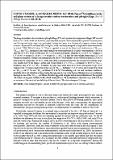Por favor, use este identificador para citar o enlazar a este item:
http://hdl.handle.net/10261/144039COMPARTIR / EXPORTAR:
 SHARE
BASE SHARE
BASE
|
|
| Visualizar otros formatos: MARC | Dublin Core | RDF | ORE | MODS | METS | DIDL | DATACITE | |

| Título: | Fate of 15N-fertilizers in the soil-plant system of a forage rotation under conservation and plough tillage. |
Autor: | Couto-Vázquez, A.; González Prieto, Serafín Jesús CSIC ORCID | Palabras clave: | Corn Italian ryegrass Lolium multiflorum plough layer soil N subsoil Zea mays |
Fecha de publicación: | 2016 | Editor: | Elsevier | Citación: | Soil & Tillage Research 161: 10-18 (2016) | Resumen: | The long-term effect of conventional plough tillage (PT) and conservation minimum tillage (MT) on soil N (0-5, 5-15, 15-30, 30-45 and 45-60 cm), recovery efficiency of 15N-fertilizer (REN), plant N concentration and N exported with crops was evaluated during two years in a 14-year-old ryegrass-maize forage rotation. Adjacent PT (n=9) and MT (n=9) plots were randomly assigned in triplicate to three treatments to which 15NH4 15NO3 (10 atom % 15N) was applied in one of the three first fertilizations (15NOctober-, 15NMarch- and 15NMay-fertilizer), the others being done with unlabelled N. Plant N concentration (% N) was affected (p< 0.001; n=18) by the crop [80 % of variance explained: ryegrass-1 (2.6 ± 0.9 %) > ryegrass-2 (1.9 ± 0.4%) > maize-2 (1.4 ± 0.1 %) > maize-1 (1.1 ± 0.2 %)] and the crop-tillage interaction (22 % of variance explained). Jointly considering all data, more 15N-fertilizer was recovered in the MT (25 ± 4 %) than in the PT soil profile (19 ± 6 %) at the end of the experiment whereas the N exported with the crops was unaffected by the tillage system and varied from 5-6 % (15NOctober-fertilizer) to 45-49% (15NMarchfertilizer) and 52-53 % (15NMay-fertilizer; despite only three instead of four subsequent crops were studied).The 15N unaccounted for in the case of 15NOctober-fertilizer (72 ± 5 %) was more than twice that in 15NMarch- (34 ± 7 %) and 15NMay-fertilizer (25 ± 14 %). Considering soil, site and weather conditions, denitrification and nitrate leaching during the ryegrass-1 crop were the most likely processes explaining the high losses of the 15NOctober-fertilizer. Results suggested a higher initial immobilization of the applied 15N in the soil organic matter (SOM) of MT, that reduces 15N availability to the first crop, followed by an increase of the residual availability of the fertilizer 15N to the subsequent 2-3 crops. | URI: | http://hdl.handle.net/10261/144039 | ISSN: | 0167-1987 |
| Aparece en las colecciones: | (IIAG) Artículos |
Ficheros en este ítem:
| Fichero | Descripción | Tamaño | Formato | |
|---|---|---|---|---|
| Couto-Vazquez_&_Gonzalez-Prieto_2016_STR_161_10-18-2.pdf | 1,08 MB | Adobe PDF |  Visualizar/Abrir |
CORE Recommender
Page view(s)
578
checked on 23-abr-2024
Download(s)
394
checked on 23-abr-2024
Google ScholarTM
Check
NOTA: Los ítems de Digital.CSIC están protegidos por copyright, con todos los derechos reservados, a menos que se indique lo contrario.
